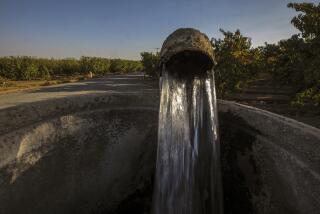The Thirst That Won’t Quit : WATER WATCH: A sprinkling of optimism can be deceiving
- Share via
It’s true that the State Water Project’s reservoirs actually filled a bit during the fifth year of drought, thanks to the “miracle” storms of March and dogged conservation efforts. Comforting as Californians will find the project’s new report, however, they must also face the uncomfortable fact that one year of marginal improvement in reservoir levels is not a solid foundation for fast-growing California.
One lesson buried in the report is that the relatively small sacrifices of lawns, shrubs and long showers that came with water rationing are permanent parts of California life. Another is that the state cannot afford to waste any more time in dragging its water policies out of the 19th Century and getting them ready for the 21st.
As a recent joint report from San Francisco’s Federal Reserve Bank and a panel of the Bay Area’s top academics and businessmen noted, the most solid foundation California can hope for is a free market in water in which it would be bought and sold much like any commodity. An important difference, the report says, is that the sale and distribution of water should be regulated much the way today’s public utility companies are regulated in supplying energy and means of communication.
The report also says that the amount of water that rural water agencies are fighting to keep is trivial--perhaps 5% of total farm supplies. Urban areas could get by indefinitely on water now used for irrigating economically marginal crops.
California probably lost a year in getting to a free market in water when Gov. Pete Wilson and the Legislature let the rural agencies block a vital bill to remove a key bureaucratic obstacle to buying and selling water.
The Bay Area report also makes clear that Sacramento cannot afford to miss another chance to write the new water policies that California needs to survive.
More to Read
Sign up for Essential California
The most important California stories and recommendations in your inbox every morning.
You may occasionally receive promotional content from the Los Angeles Times.













